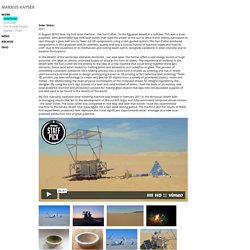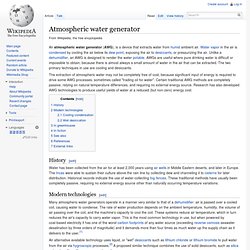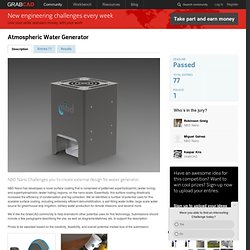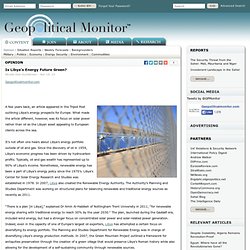

SolarSinter : markus kayser. Solar Sinter 2011 In August 2010 I took my first solar machine - the Sun-Cutter - to the Egyptian desert in a suitcase.

This was a solar-powered, semi-automated low-tech laser cutter, that used the power of the sun to drive it and directly harnessed its rays through a glass ball lens to ‘laser’ cut 2D components using a cam-guided system. The Sun-Cutter produced components in thin plywood with an aesthetic quality that was a curious hybrid of machine-made and “nature craft” due to the crudeness of its mechanism and cutting beam optics, alongside variations in solar intensity due to weather fluctuations. In the deserts of the world two elements dominate - sun and sand. The former offers a vast energy source of huge potential, the latter an almost unlimited supply of silica in the form of quartz.
Atmospheric water generator. An atmospheric water generator (AWG), is a device that extracts water from humid ambient air.

Water vapor in the air is condensed by cooling the air below its dew point, exposing the air to desiccants, or pressurizing the air. Unlike a dehumidifier, an AWG is designed to render the water potable. AWGs are useful where pure drinking water is difficult or impossible to obtain, because there is almost always a small amount of water in the air that can be extracted. The two primary techniques in use are cooling and desiccants. The extraction of atmospheric water may not be completely free of cost, because significant input of energy is required to drive some AWG processes, sometimes called "trading oil for water".
History[edit] Modern technologies[edit] Many atmospheric water generators operate in a manner very similar to that of a dehumidifier: air is passed over a cooled coil, causing water to condense. Cooling condensation[edit] Example of cooling-condensation process. Wet desiccation[edit] Atmospheric Water Generator. NBD Nano Challenges you to create external design for water generator.

NBD Nano has developed a novel surface coating that is comprised of patterned superhydrophilic (water loving) and superhydrophobic (water hating) regions, on the nano-scale. Essentially, this surface coating drastically increases the efficiency of condensation and fog collection. We’ve identified a number of potential uses for this scalable surface coating, including extremely efficient dehumidification, a self-filling water bottle, large scale water source for greenhouse drip irrigation, military water production for remote missions, and several more. We’d like the GrabCAD community to help brainstorm other potential uses for this technology. Submissions should include a few paragraphs describing the use, as well as diagrams/sketches, etc. to support the description. Prizes to be awarded based on the creativity, feasibility, and overall potential market size of the submission. Is Libya’s Energy Future Green? - Geopolitical Monitor.
Is Libya’s Energy Future Green?

Nicolai Due-Gundersen - Apr 14, 13 Geopoliticalmonitor.com A few years back, an article appeared in the Tripoli Post outlining Libya’s energy prospects for Europe. What made the article different, however, was its focus on solar power rather than oil as the Libyan asset appealing to European clients across the sea. It’s not often one hears about Libya’s energy portfolio outside of oil and gas. “There is a plan [in Libya],” explained Dr Amin Al-Habibeh of Nottingham Trent University in 2011, “for renewable energy sharing with traditional energy to reach 30% by the year 2030.”
In a sense, such projects are not surprising given the strong potential for solar power in Libya. The idea of a Libyan renewable sector is not new. Eni, Libya’s traditional oil partner recently announced an intention to invest up to 8 billion USD in Libya’s hydrocarbon infrastructure. However, there are other factors to take into account.